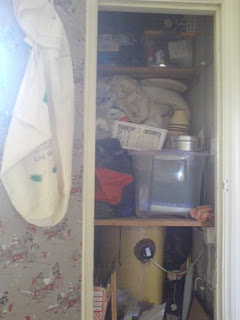 Today is a good one. I had enough energy to go and sort out the airing cupboard, which is huge and full of junk. And, as you would expect with this kind of domestic bliss, I came across a long-forgotten gem. Several years ago my mother gave me a set of four encyclopaedias, called The World of the Children, she said she bought them for me when I was a child, and sure enough I found them tucked up in a box at the back of the cupboard. I flicked through the pages and the smell took me instantly back to sitting under the stairs (not in a cupboard!) devouring facts (so few of which stayed...) and looking at pictures of amazing things I'd never seen, or was ever likely to. I lingered over the books, when I should have been getting on with the sorting out, and came across a chapter titled Section Twelve: The Fine Arts, Chapter 4, Beautiful Pictures. Of course I had to have a read. And this, dear readers, is what I read...
Today is a good one. I had enough energy to go and sort out the airing cupboard, which is huge and full of junk. And, as you would expect with this kind of domestic bliss, I came across a long-forgotten gem. Several years ago my mother gave me a set of four encyclopaedias, called The World of the Children, she said she bought them for me when I was a child, and sure enough I found them tucked up in a box at the back of the cupboard. I flicked through the pages and the smell took me instantly back to sitting under the stairs (not in a cupboard!) devouring facts (so few of which stayed...) and looking at pictures of amazing things I'd never seen, or was ever likely to. I lingered over the books, when I should have been getting on with the sorting out, and came across a chapter titled Section Twelve: The Fine Arts, Chapter 4, Beautiful Pictures. Of course I had to have a read. And this, dear readers, is what I read...
When photography was invented, artists turned in disgust from painting Nature and concentrated on doing things the camera could not do. ...they became very vague about their aims, different groups of artists having different ideas about what they ought to do; and some artists to-day are doing very queer work because they have queer ideas as to what is good art. Many strange pictures owe their existence to the idea that design is the important thing in a picture - design and not subject-matter. But many painters of queer pictures have been unkindly treated, and so you can now see queer pictures, that besides being designs, are expressions of dislike and contempt for ordinary people. Much of the work of Rouault is of this kind.
...The age of bizarre patterns masquerading as paintings will probably pass away and then artists will be found to have intentions again over and above those of mere designers.

I love it! I think it's where I must've got all my balanced views from... A quick look at the date of publishing reveals that this gem went to print in 1964 (Caxton) and was written by one Stuart Miall. Funny how I remember
Rouault (link to info on Tate's website), but not Miall.



No comments:
Post a Comment